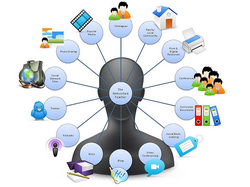Technology Integration

Technology Integration is the use of technology tools in general content areas in education in order to allow students to apply computer and technology skills to learning and problem-solving. Technology resources are computers and specialized software, network-based communication systems, and other equipment and infrastructure. Practices include collaborative work and communication, Internet-based research, remote access to instrumentation, network-based transmission and retrieval of data, and other methods. This definition is not in itself sufficient to describe successful integration: it is important that integration be routine, seamless, and both efficient and effective in supporting school goals and purposes.
The approach comes from Fairfax County Public Schools (FCPS) of Virginia. They have determined eight teacher technology competencies, divided into two competency skill areas: operational (standards 1-4) and integration (standards 5-8).
Operational Standards
Instructional personnel shall be able to:
Instructional personnel shall be able to:
The goal of placing technology in the classroom is to provide new ways for students to learn. Proper integration of technology will make the technology support these new ways of learning transparently. When students are able to choose and use technology tools to help themselves obtain information, analyze, synthesize, and assimilate it, and then present it in an acceptable manner, then technology integration has taken place.
Establishing and implementing technology literacy standards for students can help guide teacher efforts to integrate technology. In particular, lists of competencies such as those provided in the examples below define expectations for student performance and can help guide teacher activities in the context of the curriculum.
The ISTE National Educational Technology Standards (NETS) project has produced technology foundation standards for students. There are six categories:
http://www.iste.org/welcome.aspx
http://nces.ed.gov/
The approach comes from Fairfax County Public Schools (FCPS) of Virginia. They have determined eight teacher technology competencies, divided into two competency skill areas: operational (standards 1-4) and integration (standards 5-8).
Operational Standards
Instructional personnel shall be able to:
- Demonstrate effective use of a computer system and utilize computer software.
- Apply knowledge of terms associated with educational computing and technology.
- Apply computer productivity tools for professional use.
- Use electronic technologies to access and exchange information.
Instructional personnel shall be able to:
- Identify, locate, evaluate, and use appropriate instructional hardware and software to support the Virginia Standards of Learning and other instructional objectives.
- Use educational technologies for data collection, information management, problem solving, decision making, communication, and presentation within the curriculum.
- Plan and implement lessons and strategies that integrate technology to meet the diverse need of learners in a variety of educational settings.
- Demonstrate knowledge of ethical and legal issue relating to the use of technology.
The goal of placing technology in the classroom is to provide new ways for students to learn. Proper integration of technology will make the technology support these new ways of learning transparently. When students are able to choose and use technology tools to help themselves obtain information, analyze, synthesize, and assimilate it, and then present it in an acceptable manner, then technology integration has taken place.
Establishing and implementing technology literacy standards for students can help guide teacher efforts to integrate technology. In particular, lists of competencies such as those provided in the examples below define expectations for student performance and can help guide teacher activities in the context of the curriculum.
The ISTE National Educational Technology Standards (NETS) project has produced technology foundation standards for students. There are six categories:
- Basic operations and concepts.
- Social, ethical, and human issues.
- Technology productivity tools.
- Technology communications tools.
- Technology research tools.
- Technology problem-solving and decision-making tools.
http://www.iste.org/welcome.aspx
http://nces.ed.gov/
